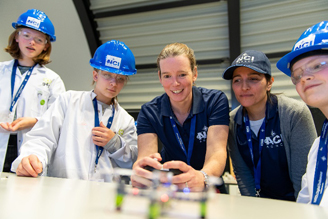Meet Laryssa Patten, an engineer working to keep NATO’s technological edge in space
Laryssa Patten is a Canadian space engineer and expert working at NATO Communications and Information (NCI) Agency. Together with experts from other NATO Allies, she helps enhance NATO’s space technologies and services.

Laryssa Patten using an unmanned aerial vehicle simulator during trial Unified Vision 18.
Laryssa has worked on space science and technology for over 20 years. This included operating on satellites for the Canadian Space Agency and leading operations for the International Space Station. “I trained astronauts to use the robotic arm on the space station,” says Laryssa. “On orbit, astronauts used it to manoeuvre large components from the Space shuttle into position on the Space Station. It was one of my best memories”.
Today, at NCI Agency – the Alliance’s technological spearhead – Laryssa focuses her job on enhancing NATO’s ability to share intelligence, be it imagery or data, among all member countries.
This critical capability is supported by space-based assets, such as satellites. Collective defence, crisis response, disaster relief and counter-terrorism – all use information delivered from and through space. Space underpins NATO's ability to navigate and track forces, to have robust communications, to detect missile launches and to ensure effective command and control. More than 2,000 satellites currently orbit the Earth, around half of which are owned by NATO member countries.
“Even our daily life depends on space more than you might think,” explains Laryssa. “Banking and navigation rely on GPS satellites in space. Broadcasting, aviation and weather forecasts all use space assets.” This dependency and other threats created an environment where NATO Allies recognised that space is an increasingly shared security issue. In 2019, NATO declared space a new operational domain – alongside land, air, sea and cyberspace.
Cooperating to keep NATO’s technological edge in space
Space capabilities are becoming more advanced, innovative, affordable and accessible. “We are experiencing an exponential growth in activity,” explains Laryssa. “We need to ensure NATO maintains it strategic advantage and this requires us to keep pace with the rapid changes in the space domain”.
Increased Alliance commitment to space will result in greater demand for NATO’s space services, requiring a new approach. This is why Laryssa is also leading the set-up of a new NATO space technology centre to focus technology and service delivery efforts into a single area. “This will allow us to address space requirements through a central focal point. And it will make it easier for NATO and industry to work together”. She is working with the Agency’s Supervisory Board, which consists of all 30 NATO member nations to determine the best path to take to launch the centre.
Laryssa also manages the Agency’s role in another critical capability of NATO: the Alliance Ground Surveillance (AGS) system, a capability based on five remotely piloted aircraft and the associated European-sourced ground command and control stations.
Getting children excited about science
Laryssa’s passion for this new frontier goes beyond work. She loves to promote space in her free time by sharing her knowledge and energy at science, technology, engineering and mathematics (STEM) events organised for children — developing the space technology professionals of the future.

“Space is a topic that can inspire anyone. Children are curious about space, stars, planets, rockets, astronauts, and more,” Laryssa explains. “This curiosity, combined with children’s dreams and imagination, is very powerful.”
In early 2020, Laryssa teamed up with greenlight for girls - an international organisation that inspires girls to pursue STEM subjects - and other partners to organise a free interactive learning event to get students excited about space. More than 100 girls from several schools in the Netherlands, aged 7 to 12, participated in a jam-packed day of hands-on workshops led by partners and supporters of the event, including the European Space Agency, the Dutch Police, and Women in Aviation (The Netherlands Chapter).
Laryssa ran the NCI Agency workshop, where participants built drones out of LEGO bricks and experimented with robots. “I enjoy speaking to children about space because they connect with it and get energised by it,” Laryssa claims. “It's a way to get them to think about the possibilities for their future careers and to keep them interested in space and science in general,” she concludes.
